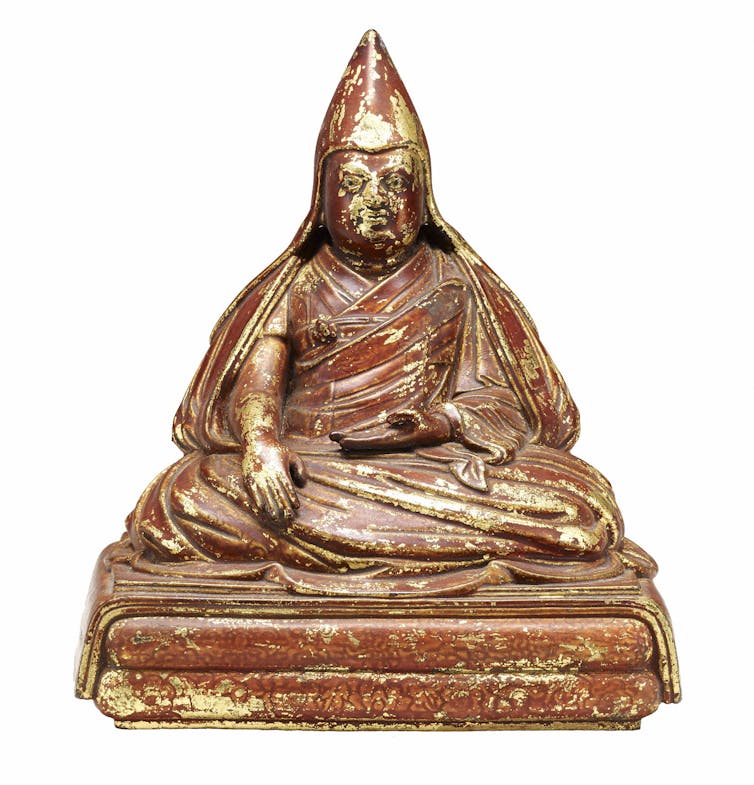One of the most secret sacred spaces in the world is now open for public perusal – in the middle of London. The Wellcome Collection has opened its doors to Tibet’s Secret Temple, an exhibition that features reconstructions of the intricate murals of the Dalai Lamas’ private meditation temple in Lhasa, the Lukhang, or “Temple of the Water Spirits”.
The exhibition is accompanied by a series of events, principle among which is one on “mindfulness”. And the timing is spot on: mindfulness is going through something of a boom at the moment. Promoted in the boardroom, staff training sessions, away-day weekends and as smartphone apps, mindfulness is trending. The Headspace app, for example, reportedly has over 3 million “happy users”, and mindfulness courses sell out within hours.
Faced by the rise of stress-related mental illness in the UK, the NHS has promoted mindfulness as an antidote to the “tunnel-vision” that results from modern living: a simple means of stopping a couple of times a day to reconnect with ourselves. For the NHS, mindfulness is a means to deal with a wide sourcepool of agitation and discontentment in the populace, hopefully before it peaks in psychiatrists’ waiting rooms.

Critics of mindfulness are not far behind, though, concerned that such simple training can act as a stand-in for proper counselling for deep mental anguish and illness. They’re almost certainly right. Mindfulness comes out of the Buddhist vipasanna traditions of “watching the mind”, and stands as one – and only one – of many meditation techniques taught in a lifelong relationship with a trained guru or lama.
By far the most complex are the tantric traditions of Tibet. These are disciplines not just intended to calm personal anxieties, but to invoke divine power as part of the goal of attaining enlightenment. These traditions connect the meditator not just to their mind, body and emotions, but to the very land that they inhabit.
Now the Wellcome puts these ideas on display in their most secret and esoteric form. Hopefully the show should increase understanding of the complexity of the ideas behind the rudimentary do-it-yourself of the mindfulness movement.
Tibet’s secret temple
The intricate murals that adorn the walls of the Lukhang Temple have been recreated by photographer Thomas Laird as “spectacular life-sized digital artworks” and form the heart of the Wellcome’s exhibition.
These reproductions are a world away from their originals. Located amidst willow trees on a small island in the middle of a lake in the northern shadow of the Potala Palace, the Lukhang temple and the island on which it stands was founded in the 17th century as a meditation sanctuary for the Dalai Lamas.

The initial island is supposed to have been constructed by the 5th Dalai Lama, who built the mudbrick Potala Palace on the crags of Marpori Hill. The legend goes that, in order to build his vast fortress-palace, mud was brought from the marsh directly to the north of the hill, leaving a large water-filled excavation.
Things did not go easily and the construction was dogged by difficulties and delays. One night, the sleeping Dalai Lama was visited in a dream by the queen of the water spirits, or lu, who owned the marsh. She complained bitterly about this disruption of her territory, and demanded recompense, so he promised a temple dedicated to the lu in the midst of the lake; only then did the building of the Potala continue unobstructed.
In time, a temple was built on the island, its walls painted with the murals. These depict the means by which the Dalai Lamas could gain mastery of their bodies. This inner mastery was not simply essential to attain Buddhist enlightenment, but also to give the meditator power over the world of gods and spirits, a power held by the Buddha himself.

For the European mind, the worlds of philosophy and meditation seem long divorced from concern with gods, spirits and demons. But for Tibetans, they are one and the same, fingers of the same hand. In 1791, the Eighth Dalai Lama enlarged the temple, placing a shrine to the water spirit Lhachen Dripdzong Tsenpa in the main sanctuary, surrounded by statues of eight peaceful spirits and several “treasure vases”. Ten years later, he performed the “lu vase realisation ritual”. It is recorded how, on this occasion:
Rain fell and so they offered lu vases to the water spirits, went round the lake on wooden boats, rode elephants, and strolled about. The metaphysicians from Sera and Drepung [monasteries] also set up a debating class there on the ‘Great Classics’, and the two lamas gave them a feast.
In the centuries that followed, Tibetans celebrated in the park surrounding the Lukhang to mark Sakadawa, the birth and enlightenment day of the Buddha, in order to “promote timely rains”. Lu vases were made and hidden by members of the Tibetan government within the lake as a means to ensure the prosperity of the kingdom.
Like many things in Tibet, the Lukhang was always the most public of all secrets, and that secret is this: mindfulness is to be mindful not just of our inner selves, but of the world around us.

